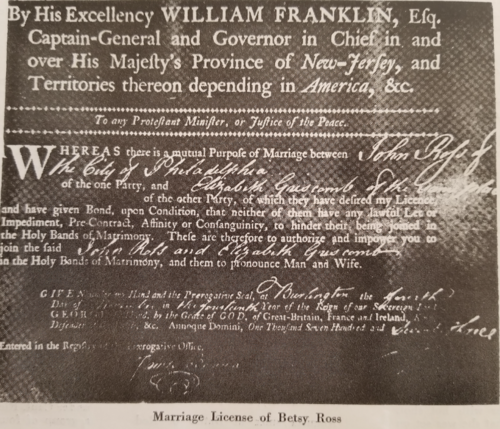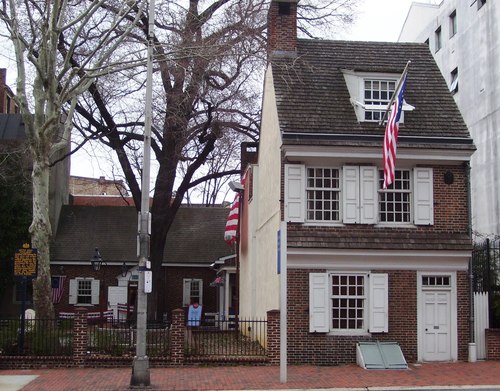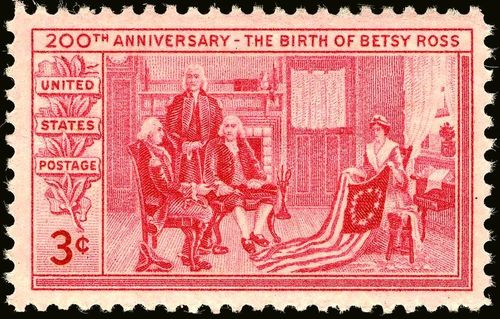John ROSS (1752-1776)
BIRD Chronicles
John ROSS (1752-1776) & Elizabeth “Betsy” Phoebe GRISCOM (1752-1836)
page established June 2008 ![]()
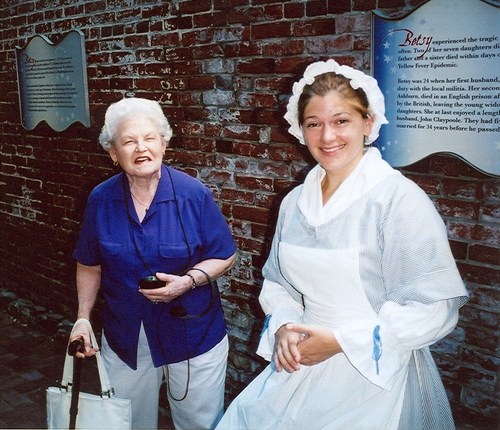
Evelyn Virginia BIRD Linton (1922-2012) talking with her cousin seamstress Betsy Ross (1752-1836) outside of her and her husband, upholster John ROSS (1752-1776) and her upholstery shop at 89 Arch Street in Philadelphia, Pennsylvania. The upholster shop was on the ground street level and their residence was the top two floors. The small winding stairs were to much for Mom so she sat and talked with Betsy while I took the 45-minute guided tour. Betsy was a great historical interrater and made a great exception for us and stepped out the back door to talk to Mom (while I took a photo (they were not alluded inside) This was on our first (of many long) road trips this one lasted three weeks covering with Isaiah LINTON (1739-1775)ís Jerusalem Mill Village in Hartford County, Maryland; Philadelphia, Pennsylvania; Bucks County, Pennsylvania and Birdsboro in Berks County, Pennsylvania.
John ROSS (1750-1776) & Elizabeth “Betsy” Phoebe GRISCOM (1752-1836)
Terry Louis Linton © 2010
Linton Research Fund Inc., Publication © 2010
LINTON & BIRD CHRONICLES, Volume V, Issue 1, Spring © 2010, ISSN 1941-3521
updated February 28, 2023
John ROSS (1750-1776) was the 4th cousin of Jeff Augustus "Gus" BIRD (1893-1954) and the 7th cousin of Kirk Louis LINTON (1914-1987).
John ROSS (1752-1777) was the son of Episcopalian Reverent Aeneas ROSS (1716-1782) & Sarah LEACH (1716-1770). John ROSS was born in 1750, in New Castle County, Delaware.
John’s father, Aeneas was born on September 17, 1716, in New Castle Colony, New Castle County, Delaware. Aeneas was christened on October 17, 1716, in the Emmanuel Episcopal Church, New Castle Colony. Aeneas was the assistant rector of Christ Church. Aeneas died in 1782, in Philadelphia, Pennsylvania, at age 66. Aeneas was buried in the Philadelphia Christ Church Yard. Aeneas Ross married Sarah LEACH (1716-1770) on January 3, 1745, in the Christ Church, Philadelphia, Pennsylvania. Sarah was born in 1716 in Philadelphia, Philadelphia County, Pennsylvania and died in 1770 in New Castle, New Castle County, Delaware.
Marriage
Elizabeth “Betsy” Phoebe GRISCOM (1752-1836) the daughter of devout Quakers married without the blessings of their parents, John ROSS (1750-1776) an Episcopalian. Betsy was later “read out” (stripped of her membership) and exiled from the meetinghouse and the Religious Society of Friends.
On November 4, 1773, John, an upholsterer's apprentice, eloped with seamstress Betsy GRISCOM. They rode the ferry form Philadelphia across the Delaware River to Huggs Tavern in Gloucester County, New Jersey, where they were wedded the same day. They were, married by William FRANKLIN (1730-1813) the son of Benjamin FRANKLIN (1706-1790).
Betsy’s Parents
Betsy was the daughter of Samuel GRISCOM (1717–1793) & Rebecca Elizabeth JAMES (1721–1793) Samuel & Rebecca were married on February 6, 1741 in Monmouth, New Jersey. Samuel was the son of Tobias GRISCOM (1686–1719) & Deborah GABITAS (1689–1730). Samuel owned a large farm and was a successful carpenter in New Jersey.
Samuel & Rebecca had children:
Deborah GRISCOM (1743–1793); Susannah GRISCOM (1744–1788); Rebecca GRISCOM (1747–1798); William GRISCOM (1748–1749); Sarah GRISCOM (1749–1785); Mary GRISCOM (1750–1793); Elizabeth "Betsy" Phoebe GRISCOM (1752–1836); Samuel GRISCOM (1753–1756); Martha GRISCOM (1754–1757); Hannah GRISCOM (1755–1836); Ann GRISCOM (1757–1759); Nancy GRISCOM (1758–?); Abigail GRISCOM (1759–1762); Joseph GRISCOM (1759–1762); George GRISCOM (1761–1835); Rachel GRISCOM (1762–1825);
Elizabeth GRISCOM was born on January 1, 1752, Philadelphia. She was the eighth of seventeen children. Her parents, Rebecca James GRISCOM and Samuel GRISCOM were both Quakers. The daughter of her father was a house carpenter. Betsy attended a Quaker school and was then apprenticed to William WEBSTER, an upholsterer. In Webster’s workshop she learned to sew mattresses, chair covers and window blinds. John and Betsy operated an upholstery shop at 89 Arch Street in Philadelphia, Pennsylvania.
Revolutionary War 1775 to 1783
John enlisted in the Pennsylvania Militia in April 1775, just after the battles of Lexington and Concord. John was guarding militia mutations in Philadelphia leaving Betsy to take full charge of their upholstery shop. John, serving under his uncle Colonel George ROSS (1730-1779), died on January 21, 1776, from wounds he received from an explosion of gunpowder on the city wharf. John Ross's "broken, bleeding and unconscious form was carried through the snow from the wharf by four militiamen to his shop. He never regained consciousness and was buried at the nearby Episcopalian Christ Church."
John died on January 21, 1776 in Philadelphia, Pennsylvania, at age 24. John was buried in January 1776, in the Christ Church Yard, Philadelphia, Pennsylvania. John Ross was the nephew of Mary Ross (1744-1790)
Betsy Ross
On June 15, 1777, twenty-two-year-old widow, Betsy married Joseph ASHBURN (1750-1782) in Philadelphia, Pennsylvania. Joseph was born in 1750 in Philadelphia, Philadelphia County, Pennsylvania. Joseph was a merchant sailor and in 1782 Ashburn was apprehended while working as a privateer in the West Indies and died in a British prison on March 3, 1782 in Old Mill, England at age 32.
Children from this marriage were:
- Zillah ASHBURN was born in 1779 in and died in 1779 in Philadelphia, Philadelphia County, Pennsylvania.
- Elizabeth ASHBURN was born on February 25, 1781 in Philadelphia, Philadelphia County, Pennsylvania.
A year later, two-time widower, Betsy married John CLAYPOOLE (1752-1817) on May 8, 1783, in the Christ Church, Philadelphia, Pennsylvania. John was born on August 15, 1752, in Mount Holly, New Jersey and died on August 3, 1817 in Philadelphia, Pennsylvania at age 64. John had grown up with her in the Philadelphia’s Quaker community and had been imprisoned in England with Ashburn. A few months after their wedding, the Treaty of Paris was signed, ending the Revolutionary War. They went on to have five daughters.
Children from this marriage were:
- Clarissa Sidney CLAYPOOLE was born on April 3, 1785 in Philadelphia, Pennsylvania and died on July 10, 1864, in Fort Madison, Madison County, Iowa, at age 79. Clarissa married Jacob WILSON in 1804 in Pennsylvania. Jacob was born 1785 in Pennsylvania and died in Fort Madison, Madison County, Iowa.
- Susanna CLAYPOOLE was born on November 15, 1786 in Philadelphia, Pennsylvania and died on June 11, 1875 in Abington, Montgomery County, Pennsylvania, at age 88. Susanna married Abel SATTERTHWAITE. Abel was born about 1786 in Pennsylvania and died in Abington, Montgomery County, Pennsylvania.
3 Rachel CLAYPOOLE was born in 1789 in Philadelphia, Pennsylvania. and died in 1873, at age 84. Rachel married Edward JONES about 1808 in Philadelphia, Pennsylvania. Edward was born in 1789 in Pennsylvania. Rachel next married John FLETCHER in Pennsylvania. John was born in 1789 in. Pennsylvania.
4 Jane CLAYPOOLE was born on November 13, 1792 in Philadelphia, Pennsylvania and died on January 4, 1873 in Colora, Cecil County, Maryland, at age 80. Jane married Caleb CANBY on July 2, 1818 in Philadelphia, Philadelphia County, Pennsylvania. Caleb was born on December 6, 1789 in Brooklyn, Kings Borrow, Long Island, New York and died in Colora, Cecil County, Maryland.
5 Harriet CLAYPOOLE was born on December 20, 1795 in Philadelphia, Pennsylvania and died on October 8, 1796
Death
Over the next decades, Betsy Claypoole and her daughters sewed upholstery and made flags, banners and standards for the new nation. In 1810 she made six 18-by-24-foot garrison flags to be sent to New Orleans; the next year she made 27 flags for the Indian Department. She continued working in her upholstery business until 1827. After her retirement, she moved in with her married daughter, Susannah Satterthwaite, who continued to operate the business. Betsy died on January 30, 1836, in Philadelphia, Pennsylvania, at age 84. Betsy was buried in February 1836, in the Mount Moriah Cemetery, Philadelphia, Pennsylvania. Her remains were relocated to the courtyard of the Betsy Ross House on Arch Street.
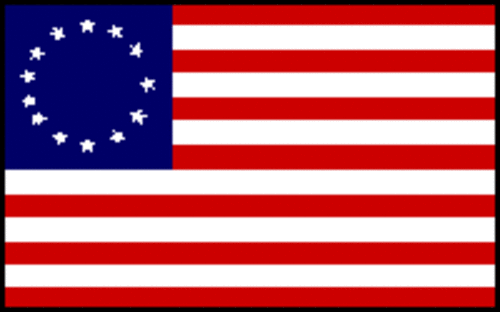
"Betsy Ross" flag
The "Betsy Ross" flag, reputedly first sewn by Betsy Ross, used as the official flag of the United States from June 14, 1777 - May 1, 1795
According to what her family members said (after her death) that she had told them, in June 1776, she received a visit from George Washington, George Ross and Robert Morris of the Continental Congress. She had met Washington through their mutual worship at Christ Church (and she had sewn buttons for him previously), and George Ross was John's uncle. Although there is no record of any such committee, the three men supposedly announced they were a "Committee of Three" (perhaps self-appointed, under the circumstances) and showed her a suggested design that was drawn up by Washington in pencil. The design had six-pointed stars, and Betsy, the family story goes, suggested five-pointed stars instead because she could make a five-pointed star in one snip. The flag was sewn from American grown hemp by Betsy in her parlor. The flag was flown when the Declaration of Independence was read aloud at Independence Hall on July 8, 1776.
No contemporary record of this meeting was made. The Betsy Ross Flag had 13 stars and stripes. George Washington said that all stars should be placed in a circle so that no colony would be viewed above another.[1]. Historians have found at least 17 other flag makers in Philadelphia at the time. The Betsy Ross story is based solely on oral affidavits from her daughter and other relatives, which were made public in 1870 by her grandson, William J. Canby, in a paper read before the Historical Society of Pennsylvania. No primary sources of the time—letters, journals, diaries, newspaper articles, official records, or business records—have surfaced since 1870 confirming or disproving the story. The only further supporting documentation that Betsy Ross was involved in federal flag design is the Pennsylvania State Navy Board commissioning her for work in making "ships colors & c." in May 1777.
Painting Below: "The Birth Of Our Nations Flag" by Charles H. Weisgerber; General George Washington (1733-1799), Colonel George Ross (1730-1779), signer of the Declaration of Independence for Pennsylvania Colony, the brother of Mary Ross (1744-1790) and uncle of John Ross (1751-1776) and brother-in-law of Colonel Mark Bird (1739-1812); Robert Morris (1734-1806) signer of the Declaration of Independence for Pennsylvania Colony and Betsy GRISCOM Ross (1751-1836).
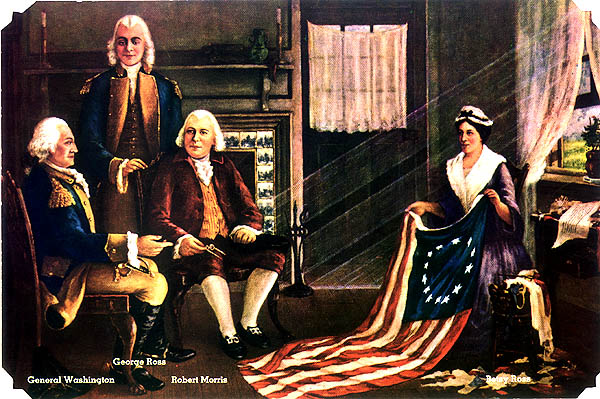
Rachel Fletcher Affidavit Dated July 31, 1871
Affidavit of Rachel Fletcher, a daughter of Elizabeth Claypoole (Betsy Ross) “I remember having heard my mother Elizabeth Claypoole say frequently that she, with her own hands, (while she was the widow of John Ross,) made the first Star-spangled Banner that ever was made. I remember to have heard her also say that it was made on the order of a Committee, of whom Col. Ross was one, and that Robert Morris was also one of the Committee. That General Washington, acting in conference with the committee, called with them at her house. This house was on the North side of Arch Street a few doors below Third Street, above Bread Street, a two-story house, with attic and a dormer window, now standing, the only one of the row left, the old number being 89; it was formerly occupied by Daniel Niles, Shoemaker. Mother at first lived in the house next East, and when the war came, she moved into the house of Daniel Niles. That it was in the month of June 1776, or shortly before the Declaration of Independence that the committee called on her. That the member of the committee named Ross was an uncle of her deceased husband. That she was previously well acquainted with Washington, and that he had often been in her house in friendly visits, as well as on business. That she had embroidered ruffles for his shirt bosoms and cuffs, and that it was partly owing to his friendship for her that she was chosen to make the flag. That when the committee (with General Washington) came into her store she showed them into her parlor, back of her store; and one of them asked her if she could make a flag and that she replied that she did not know but she could try. That they then showed her a drawing roughly executed, of the flag as it was proposed to be made by the committee, and that she saw in it some defects in its proportions and the arrangement and shape of the stars. That she said it was square and a flag should be one third longer than its width, that the stars were scattered promiscuously over the field, and she said they should be either in lines or in some adopted form as a circle, or a star, and that the stars were six-pointed in the drawing, and she said they should be five pointed. That the gentlemen of the committee and General Washington very respectfully considered the suggestions and acted upon them, General Washington seating himself at a table with a pencil and paper, altered the drawing and then made a new one according to the suggestions of my mother. That General Washington seemed to her to be the active one in making the design, the others having little or nothing to do with it. That the committee then requested her to call on one of their number, a shipping merchant on the wharf, and then adjourned. That she was punctual to her appointment, and then the gentleman drew out of a chest an old ship's color which he loaned her to show her how the sewing was done; and also gave her the drawing finished according to her suggestions. That this drawing was done in water colors by William Barrett, an artist, who lived on the North side of Cherry Street above Third Street, a large three story brick house on the West side of an alley which ran back to the Pennsylvania Academy for Young Ladies," [note missing open quotation mark, probably meant before "Pennsylvania Academy" --Webmaster] kept by James A. Neal, the best school of the kind in the city at that time. That Barrett only did the painting, and had nothing to do with the design. He was often employed by mother afterwards to paint the coats of arms of the United States and of the States on silk flags. That other designs had also been made by the committee and given to other seamstresses to make, but that they were not approved. That mother went diligently to work upon her flag and soon finished it, and returned it, the first star-spangled banner that ever was made, to her employers, that it was run up to the peak of one of the vessels belonging to one of the committee then lying at the wharf, and was received with shouts of applause by the few bystanders who happened to be looking on. That the committee on the same day carried the flag into the Congress sitting in the State House, and made a report presenting the flag and the drawing and that Congress unanimously approved and accepted the report. That the next day Col. Ross called upon my mother and informed her that her work had been approved and her flag adopted, and he gave orders for the purchase of all the materials and the manufacture of as many flags as she could make. And that from that time forward, for over fifty years she continued to make flags for the United States Government.
I believe the facts stated in the foregoing Article entitled "The First American Flag and Who Made It," are all strictly true. This affidavit having been signed by Rachel Fletcher with violet ink, the signature has faded, but is at this time, Seventh Month 24th, 1908, still plainly legible.
Rachel Fletcher
I, Mary Fletcher Wigert, daughter of the said Rachel Fletcher, recognize the signature in the rectangular space outlined in black above, as the signature of my mother Rachel Fletcher.
John Ross & Betsy Ross' upholstery shop at 89 Arch Street in Philadelphia, Pennsylvania. The upholster shop was on the ground street level and their residence was the top two floors. Photo by Terry Louis Linton.
This 1952 stamp was given to me in 1956, by my Grandma Linton, Annie Lucretia CRONK (1888-1956) a long with her full stamp collection she had stated as a young girl.
Linton Research Fund Inc., Publication © 1987-2025 "Digging for our Roots"

Main Menu
Linton Research Fund, Inc., HOME PAGE
LINTON Chronicles Table of Contexts
LINTON Ancestors in the Revolutionary
LINTON Ancestors in the Civil War 1861-1865
BIRD Chronicles Table of Contents
Bird Ancestors in the Revolutionary War
BIRD Ancestors in the Civil War 1861-1865
Today's Birthdays & Anniversaries
History of the Linton Research Fund Inc., LINTON & BIRD Chronicles
LINTON & BIRD Chronicles on Facebook
![]() "Thanks for Visiting, come back when you can stay longer" Terry Louis Linton © 2007
"Thanks for Visiting, come back when you can stay longer" Terry Louis Linton © 2007
Linton Research Fund Inc., Publication © 1987-2025 “Digging for our roots”
LINTON & BIRD Chronicles
Established 1984
Quarterly Publication of the Linton Research Fund Inc. ![]()
